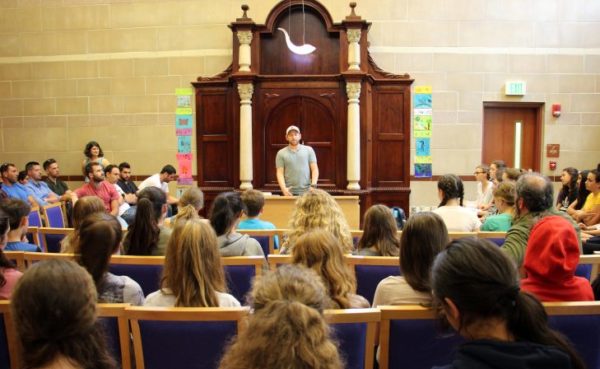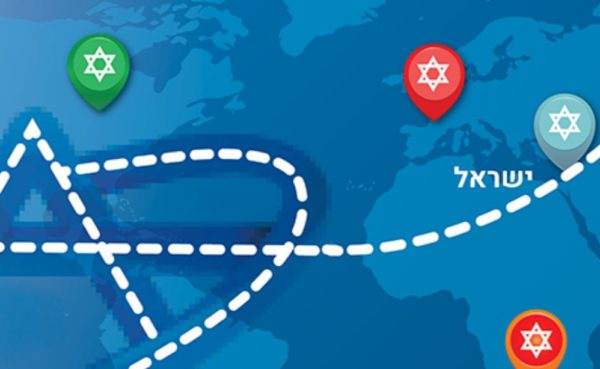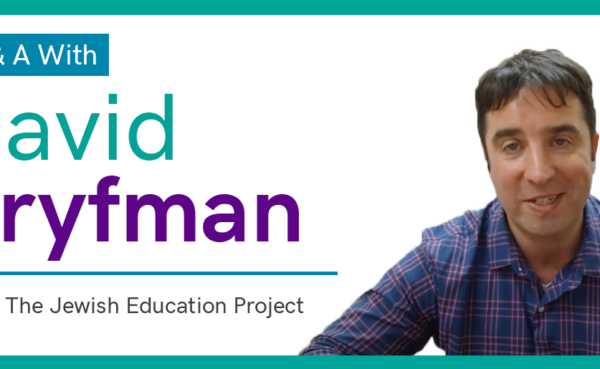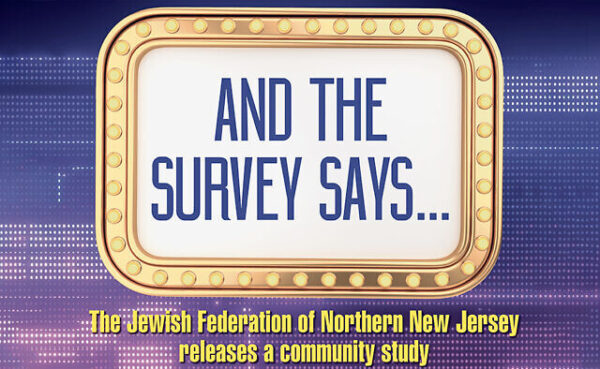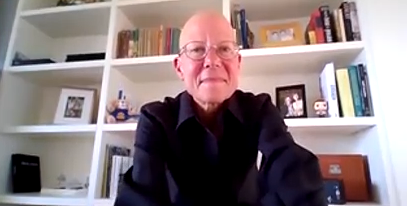
Wendy Rosov’s Commencement Address for Jack M. Barrack Hebrew Academy
On June 11, 2020, Wendy Rosov delivered this commencement address to Jack M. Barrack Hebrew Academy’s graduating Class of 2020 via Zoom. Please note that the audio recording begins about two minutes into the speech.
Good evening. I would like us all to take a deep breath. Look around the room — both IRL and virtual — the people you are with. Now close your eyes. Let’s take a moment of silence. Our country is hurting right now as we mourn the lives of George Floyd, Ahmaud Arbery, and Breonna Taylor and over 100,000 U.S. lives lost to COVID-19. These are heartbreaking times.
Now… let’s open our eyes, take another deep breath, look around you, and turn our attention to celebrating.
When I first saw the email from Sharon and her team asking to have a conversation about the Class of 2020, I thought to myself, “What could this possibly be about?”
I agreed to a Zoom meeting, “back then” when Zoom was a novelty for many. Sharon, in what I have come to know as her inimitable fashion – full of vim and vigor, full of passion – proceeded to inform me that she, her team, and you, the Class of 2020, wanted to know if I would be willing and able to come to Philly in June to speak at your graduation.
I was floored. Speechless. Not generally an adjective commonly used to describe me.
All kinds of thoughts raced through my head in rapid-fire succession:
What?
Me?
Seriously?
Why?
What could I possibly have to offer? (especially compared to “Famous” alums, like Jake Tapper and Mitch Albom who I understand have graced the commencement dais in years past?)
Sharon, perhaps sensing my apprehension, jumped onto my train, or train wreck, of thought and said:
This is an Amazing Class
They are Our Largest to Date
They are Athletic
They are Gay, Straight, Allied, and Aligned
They are Thoughtful
They are Deeply Engaged in Jewish Community
They are Diverse
You, Wendy, have so much to offer to them.
Well, that moved me to the next phase of “Whoa, OK, this is awesome… I can do this — I want to do this!” And so I started throwing out ideas of what I could talk about and, in so doing, went from incredulous and speechless to, well, stoked. The floodgates had opened into a stream of deep and fond memories of my time at Akiba, as well as ideas centered on your time at Barrack. We were cooking with gas.
I told Sharon and Rebecca I would be honored. And I meant it. We sealed the deal.
I put a pin in it. Meaning, for me, I went into hyper logistics. I have flown 2.5 million miles on United and another 1 million on other airlines since I began my, well, third or fourth career — depending on how you count — and am constantly on the road. I blocked out the dates on my calendar to be sure that I could attend my daughter Gaby’s graduation from her “small school” at Berkeley High on June 5, with 200 graduates, on the front end, and the “whole school” senior class commencement with 800 kids in her class on June 13, on the back end. Beautifully, miraculously, June 11 fit right in the middle. It was all going to work out.
With logistics squared away for the time being, I put this speech on my long-term to-do list and smiled at the prospect.
That was back when the world was, normal. Less than six months ago.
Fast Forward.
By the middle of March it had become apparent that all of my plans, and way more importantly, all of YOUR plans, were likely not to be. I sent an email to Sharon and Rebecca suggesting we set a time to talk. They agreed.
Slight diversion — by this point, I was sheltering in place at our second home on the Northern Sonoma coast. With a bout of pneumonia only a year behind me and two autoimmune conditions, one of which is alopecia, which you can see by the fact that I have no hair on my head, not by choice(!), my doctor strongly advised that I “get out of Dodge” (in this case, Berkeley) fast. And so on March 16, my life-partner Peg, our youngest daughter Gaby (the senior at Berkeley High), and our foreign exchange student from Germany, Esther, piled in our cars and drove 2.5 hours north.
Within a matter of days, two things became abundantly apparent: First, Esther’s year abroad living with us would be cut short — she would have to go back to Germany soon. Second, the despondency and despair of the inevitable loss of so many rites of passage at the end of Gaby’s high school career had begun to take hold and the isolation of this space — so good for me — was so terrible for her.
As I set out to share some thoughts with you this evening, I want to say that while I don’t know most of you, I can relate. As the parent of a high school senior, class of 2020, I can relate. As a graduate of this amazing school, I can relate. My hope is that you find in something of what I say here tonight something you can relate to.
One of my professors at Stanford, where I did my PhD in Education, advised me before my oral defense: “tell them what you are going to say, then say it, then remind them of what you said.” So, in homage to this professor… In this talk, that I hope will be followed by some rich conversation, I hope to take you on a journey, akin to the one we just traversed between Pesach and Shavuot. This journey I hope to take you on starts with Yitziat Mitzrayim, our exodus from Egypt, moves to the Omer, where I will talk about counting, then on to Matan Torah, and ends with Redemption — in this case, a charge for the future — your future. Because I was told that all good commencement speeches must have a “charge” at the end. Let’s see how I do.
In Chapter 12 of Shemot, we learn about the Israelites’ exodus from Egypt. The text states:
(לח) וְגַם-עֵרֶב רַב, עָלָה אִתָּם, וְצֹאן וּבָקָר, מִקְנֶה כָּבֵד מְאֹד
(38) And a mixed multitude went up also with them; and flocks, and herds, even very much cattle.
A mixed multitude also went up (out of Egypt) with them, the Israelites.
The Torah, which is at best a spartan document with so much left open for inference and filling in, for some reason goes to the trouble of telling us, in this most propitious moment of our collective history, that we left Egypt along with, a PART OF, a mixed multitude.
What could this possibly mean?
Rashi, compelled to comment on the phrase “erev rav”, says that the “ערב רב = תַּעֲרֹבֶת אֻמּוֹת שֶׁל גֵּרִים”, that is, a mingling of various nations of converts to Judaism. Ibn Ezra, one of Rashi’s contemporaries, takes a different tack. He contends that the “erev rav” were Egyptians (non-Jews and non-converts) who had, in Egypt, been “mixed in” with the Israelites. He uses the Hebrew הָֽאסַפְסֻף – which has been translated by many as “riffraff” but actually comes from the Hebrew word “gather” (le’esof)– meaning, those that were gathered among them, which is a much friendlier and I daresay more accurate translation of the word.
While these two readings are pretty much descriptive and, inasmuch, a “positive” reading and rendering of the text – it turns out that most of the rabbis of the Midrash and Talmud tend to disfavor the “erev rav” – the mixed multitude – scapegoating them for any number of failings and backslidings by the Israelites during their desert wandering. These failings and backslidings include, on the most severe, the making of the egel zahav, the golden calf, as they, the mixed multitude, collectively, stood at Sinai, to the more general protests of complaints and ingratitude expressed by B’nei Yisrael all along the 40-year journey.
Aside from Rashi and Ibn Ezra, so far, our view of the “erev rav” – the mixed multitude – is not a pretty one. It gets worse. Much worse.
Haim Vital, an influential 16th Century Kabbalist who was a student of the famed Isaac Luria, went so far as to state, in Sefer Ha-liqqutin, that “the essence of sin of Adam was that he wanted to draw near to him the mixed multitude … And Moses followed the same pattern when he drew to him the mixed multitude, and they destroyed and degraded the yolk by making the calf and we are still in exile and will not be redeemed until we are cleansed and purified from them.”
There are many more texts and examples I can bring of how this negative and disparaging view of the “erev rav” – the mixed multitude — has been pervasive in our collective consciousness — persisting through millennia, even into contemporary times. Suffice it to say, our sages and our community has struggled with, has had mixed emotions about, our mixed multitudeness since our very beginnings.
That’s our moment of Exodus.
Now I want to turn to Omer – to counting.
Judaism has tons of rules about counting. What gets counted, who gets counted, how we count (or don’t). Our liturgy, our laws, and our lore are filled with them. A biggie is that we are not supposed to count Jews – as the prophet Hoshea says, “And the number of the children of Israel shall be as the sand of the sea, which shall neither be measured nor counted.”
But we do.
The first attempt to estimate the Jewish population in the U.S. post-World War II was in 1957 – when a single question was added to the U.S. Census Bureau’s “CPS” or Current Population Survey. In the survey, respondents (or “subjects” as they were called back in the day) were presented with a voluntary open-ended (think “write in”) question that read: “What is your religion?” That was it.
The year 1970 marked the first National Jewish Population Study in the U.S., sponsored by what was then called the Council of Jewish Federations (now JFNA or the Jewish Federations of North America). The demographers (those who study such things) had to tackle definitional questions of both “Who Counts” and “What is Worthy of Counting” for the sake of, well, counting. A fairly extensive set of questions was used to determine if the respondent was born Jewish, is now Jewish, and whether the mother, father, grandparent, etc. of the respondent was born Jewish. One question on marital status assumed heteronormativity. A second did ask about the spouse’s religion, suggesting a recognition that a Jew could be married to a “non-Jew.” A single question on gender was limited to a binary response (male or female). Two things stand out: first, the survey acknowledged and included those who converted to Judaism; second, the survey seemed to acknowledge that someone who counted as Jewish could have only one Jewish parent, not two. This study was perhaps an initial recognition that estimates of the Jewish population in the U.S. ought to take into account some aspects of our “mixed multitudeness.” However, questions on race, ethnicity, and sexual orientation were absent.
The next National Jewish Population Study, sponsored again by the Federation movement, took place in 1989–90. The question on gender was still binary. There were still a couple of questions on conversion, and we continued to ask questions about in-marriage and intermarriage. The demographers added their first question on Jewish ethnicity asking respondents to state whether they consider themselves Ashkenazi, Sephardi, or “something else” – including “Russian Jewish, Just Jewish, None, Christian/Not Jewish, Mixed, Hasidic/Lubavitch/Chabad, American, Reform, Miscellaneous/Other.” A bizarre set of choices. Still no question on sexual orientation. Still no question on race.
Sadly, pretty much all of the findings from the 1989–90 NJPS were totally eclipsed by one single data point: the now infamous 52% intermarriage rate. This set off a firestorm in the broader U.S. Jewish community — with the establishment of Jewish “continuity” commissions all around the country whose sole purpose was to “stem the tide” of intermarriage. It seems that most, but not all, of our communal policymakers decided that our “mixed multitudeness” had simply gone too far and now was the time to ACT.
A few things happened in the wake of the NJPS report, which came out in 1992:
Birthright Israel was born in 1994 — the brainchild of two Jewish megadonors, Charles Bronfman and Michael Steinhardt. According to one narrative, Birthright Israel was brought into existence to bridge what was purported to be a growing “distancing” between U.S. and Israeli Jews. According to another narrative, the one I would put more stock in as a student of such things, it was brought into existence to get young Jews on a boondoggle for 10 days so they could meet other young Jews, marry them, have more Jewish babies, and thus stem the tide of intermarriage and a shrinking Jewish population if you only count “the core.”
Two years later, in 1996, Keshet, a national organization working for the full equality of all LGBTQ Jews and their families in Jewish life, was born.
One year later, in 1997, InterfaithFamily (now 18Doors) was born.
Our mixed emotions about our mixed multitudeness came into sharper relief.
The NJPS was conducted once again, it turns out for a final time, in 2000–2001. Digging into parentage and lineage to establish one’s Jewish credentials for the converts among us was, thankfully, less obtrusive. Questions about in-marriage and intermarriage continued. Gender was still binary. Still no question on sexual orientation. The ethnicity question was dropped, and for the first time our demographers included a question on race. In the end of the day the biggest takeaway from the 2000–2001 NJPS was, well, that Hoshea was right after all — the Jews should stop counting the Jews. Not because God had decreed it, not because the rabbis later came up with all sorts of other reasons (like counting brings on the ayin ha-ra), but, well, frankly, because the demographers got into a big fight about how best to count and the Federation movement decided that the whole enterprise was no longer worth the time, money, or headache. Oy.
The final chapter, to date, in our Omer, our counting story, is A Portrait of Jewish Americans, a report of the Pew Research Center for Religion and Public Life released in 2013. This now oft-quoted study introduced us to the religious “nones” (that’s N-O-N-E-S), the cultural (as distinct from religious) Jews, a 58% intermarriage rate (71% if you exclude those who self-identify as Orthodox), and an estimation that 6% of our community is comprised of Jews of Color (some scholars of American Jewish life say that number may be as high as 15% due to “under-counting” or not-counting.
Three years later, in 2016, the Jews of Color Field Building Initiative was founded. Our “erev rav” was expanding.
That’s the end of my Omer – the part of this journey that focuses on counting.
I now want to turn our attention to the next part of this journey — to Matan Torah — the gift of teaching, the gift of showing.
One of the main findings of the 1989–90 NJPS that got eclipsed by the “continuity crisis” of a 52% intermarriage rate, was that having a Jewish day school education is one of the strongest predictors of becoming a deeply connected, committed, and involved Jewish adult. In fact, later analyses of the data showed that 7+ years of Jewish day school education was pretty much the secret sauce for ensuring such an outcome. (All I will say here is thank god you people figured out how to have one sixth grade and not two… Because now everyone can have seven years of Barrack! But I digress…)
I believe the founders of Akiba Hebrew Academy (and here, for a while, I am going to use the school’s original name) harbored this belief — it was their anchor in a stormy sea of criticism lodged against them and their successors during the school’s early years. This criticism primarily revolved around the notion that day schools were “un-American” — separating and segregating Jewish students from other American youth.
[Permit me to take a personal digression here — I am the youngest of three kids in my family. My brother and sister attended Samuel L. Gompers for elementary school because my father firmly believed that Jewish day schools were insular, un-American, and otherwise not good for the Jews and especially not good for his kids. My mother firmly believed the opposite. By the time I was kindergarten-ready, my parents had divorced and my mother enrolled me in Solomon Schechter. She was a fierce believer in the power of a Jewish day school education and did everything in her power to make sure that it was there I stayed for all 12 years. She is 89 ½ and she is listening in this evening from her apartment in Cherry Hill. To her I want to say “THANK YOU” for the gift of a Jewish day school education. It has made me who I am today.]
Okay, back to our narrative of Matan Torah: The Gift of Teaching — What made Akiba extra special then and continues through Barrack today, is its commitment to Jewish pluralism and inclusivity.
Unbeknownst to me before I started working on this address, Dr. Harold Gorvine — or “Groovy Gorvy” as we affectionately called this constantly disheveled, absent-minded professor-type teacher of American History back in my day — wrote an obscure monograph called “Akiba Hebrew Academy: History and Personal Reflections.” This monograph was apparently the third in a series published by something called the Akiba Hebrew Academy Press Center for Educational Initiatives — who knew there was such a thing?!
The monograph opens as follows:
Akiba Hebrew Academy, the first community-wide secondary Jewish day school in the United States, was founded in 1946 by a group of public-minded Jewish citizens … who were deeply concerned about preparing students to assume responsibility in their community as leaders and active citizens.
… It was the view of the founders [Gorvine went on to write] that all Jewish children – affiliated and non-affiliated – should come together under one roof to study their common Jewish heritage while simultaneously learning to respect all positions and the devotion and sincerity with which they are held. This objective was not intended to blur differences. Rather, it was intended to strengthen the Jewish identification of every student without compelling acceptance of one particular interpretation of what is “THE” Jewish way of life.
Akiba, it turns out, was the first community-wide Jewish day school in the United States. In its founding was an appreciation for the power of the erev rav — bringing together the mixed multitude of those coming from different walks of Jewish life, holding the space for a radically pluralistic and inclusive Jewish experience.
Thirty years later, in the Fall of 1976, I entered Akiba as a seventh grader (yeah, I kept on at Schechter through sixth grade!). There is so much about my time at Akiba that, to this day, I recall, cherish, hold dear … most centering around the amazing morim, teachers. They were an amazingly diverse group of educators who showed me the way, even when I was pushing back, misbehaving, and downright difficult. I am sure if they were here tonight, they would tell you that I was a hell-raiser. It turns out that I was a straight-A (well, except Chemistry where I could not grasp the concept of balancing equations), three-sport, leading play character (always in a male role, mind you), yearbook editing, Israel Independence Day parade leading, and so much more hell-raiser.
I was also secretly struggling. True to the vision of its founders, Akiba was inclusive and pluralistic but only if you were white, heteronormative, Jewish by birth, and from an in-married family. As I entered into Akiba, I started to feel that I wasn’t passing the Sesame Street test – one of these things, ME, was not like the others. I realized I was gay. I also realized I had to keep it to myself as I did not see my emerging reality reflected in any aspect of the school’s culture and community. There was no GSA, that’s for sure! (And I will spare you all the faggot and dyke jokes that got thrown around unchecked, day after day.)
I stayed in the closet through my senior year. I decided that Judaism and being gay were incompatible. I turned down the offer to the double-degree program at Barnard/JTS, choosing to enroll only in Barnard for college. I came out of one closet and went into another. It took 10 long years before I found my way back into Jewish community, finally integrating my gay and Jewish self.
That was then. This is now.
Having explored the Exodus (Yitziat Mitzrayim), the counting (Omer), and the teaching (Matan Torah), I want to turn finally to the future, your future, the redemptive charge.
You are squarely in the middle of what sociologists call Gen Z. Your generation is deeply concerned about climate change, racial and other forms of social injustice, and 70% want a more activist government that will do more to solve our biggest problems. One-third of your generation say they personally know someone who prefers to go by gender neutral pronouns; roughly half say that gays and lesbians being allowed to marry is a good thing.
Roughly 24 million of your cohort will be eligible to vote in the 2020 election.
Your generation is a true “erev rav” — the most ethnically and racially diverse generation in American history to date. A bare majority, 52%, are white. Nearly 25% of your generation have at least one parent born outside the U.S.
Your time at Barrack has been deeply steeped in Jewish values — Kavod (honor), Ometz Lev (courage), Hesed (kindness), and, last but perhaps most important, Kehillah (community). It is this last value I want to linger on for a moment before wrapping up.
Diana Eck, a scholar of Religious Studies and Director of the Pluralism Project at Harvard, writes:
Pluralism is not diversity alone — it is the energetic engagement with diversity.
It is not just about tolerance, but the active seeking of understanding across lines of difference.
Pluralism is not relativism, but the encounter of commitments.
Pluralism is based on dialogue, encounter, give and take and self-criticism.
I see Eck’s poignant rendering of pluralism reflected in Barrack’s core value of Kehillah, of community, particularly as expressed through the charge to respect and celebrate both your individuality and your diversity — your “erev rav,” your mixed multitudeness.
It turns out lots has been written about Akiba Hebrew Academy. Historians seem to have a fascination with the origin story of this, at the time, radical experiment in Jewish education. In her doctoral thesis, The Reshaping of Jewish Identity 1945–1960, my colleague Valerie Thaler spends an entire chapter on the history of the founding of Akiba. According to Thaler, “choosing the name of the school was deeply symbolic as it was taken from a Talmudic scholar and martyr during the Jews’ struggle against Rome.” Joseph Levitsky, Chair of Akiba’s Education Committee at the school’s founding, was purported to have stated that Akiba’s students would also, like their namesake, remain committed to Jewish life during “momentous days” in which they lived.
I think we all can agree, graduates, parents, and your teachers alike, that there are no more momentous days than these. At Barrack you have learned to dialogue across difference, disagree without defaming, encounter, and engage. You have had a remarkable education and experience — doing so all within the context of an “erev rav.” Whereas the Kabbalist Vital claimed that we would not be redeemed until we are “cleansed and purified” of them, the “erev rav,” the mixed multitude, Barrack shows us that it is nothing short of our mixed multitudeness as a Jewish community that is redemptive in and of itself. You, in all of your individuality and your diversity, the Barrack grads of 2020, possess the habits of hand, mind, and heart to lean in and bring about positive change in our world today.
I wish you every success.
Wendy Rosov
The Sea Ranch, CA
June 11, 2020
